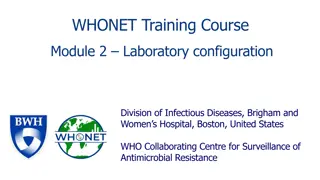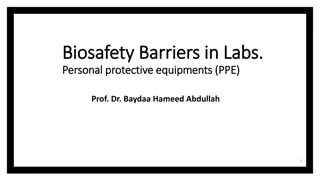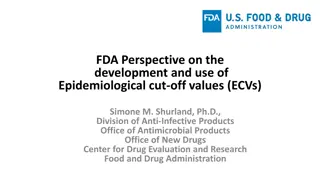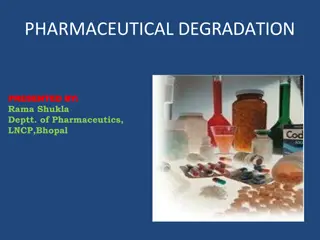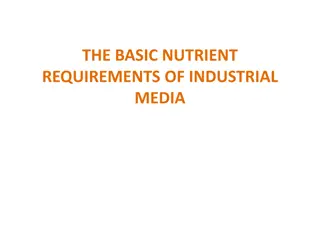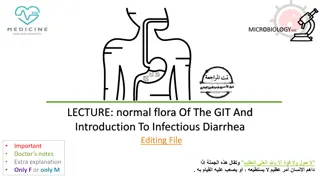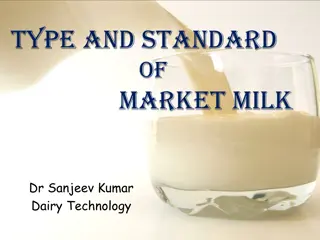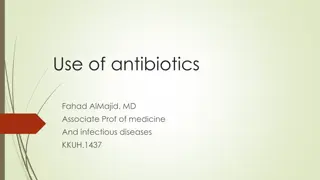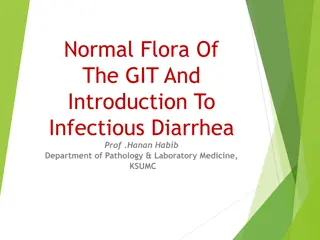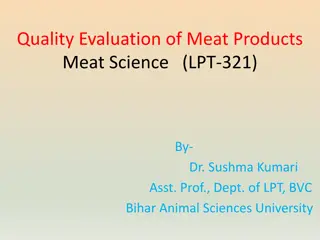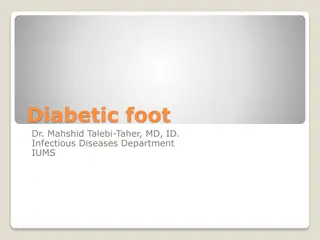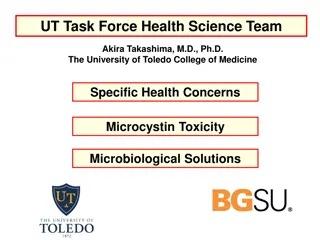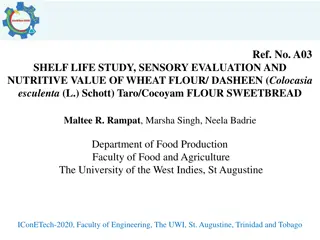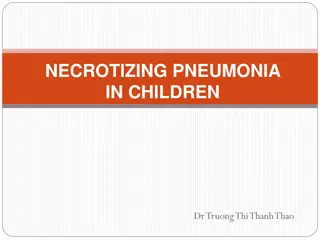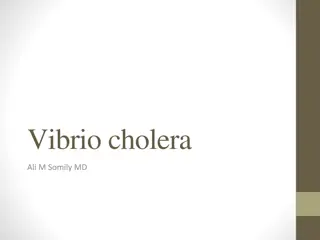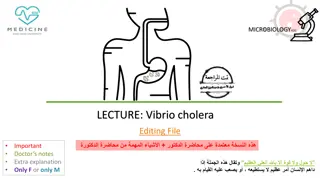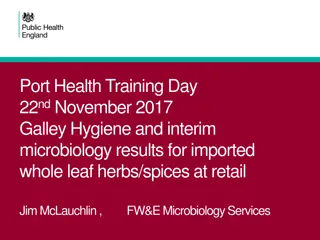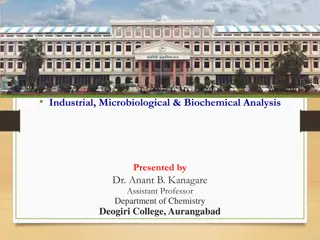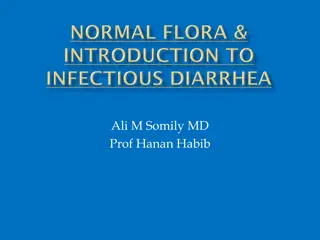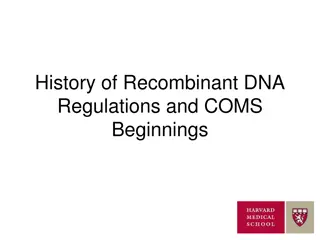WHONET Training Course: Laboratory Configuration and Setup
Understanding the laboratory configuration process in WHONET is crucial for effective data entry and analysis. This module guides users on setting up a new laboratory, entering country and lab details, defining antibiotics, sample locations, and data fields, creating microbiological alerts, and savi
3 views • 57 slides
Food spoilage
In this lecture from the Department of Pathological Analyses at the University of Basrah, Prof. Dr. Saad S. Mahdi Al-amaradi Al-Amara discusses food spoilage, focusing on cereals, bakery foods, and meat products. The presentation covers the microbial spoilage of grains, including common mold species
0 views • 9 slides
Ensuring Biosafety in Laboratory Settings: Barriers and Practices
Biosafety in laboratories involves implementing various barriers and practices to prevent the release of biological agents and protect lab workers. These include primary and secondary barriers, personal protective equipment (PPE), containment principles, and adherence to biosafety practices. Safety
1 views • 41 slides
FDA Perspective on Epidemiological Cut-off Values (ECVs)
The FDA presents insights on the development and use of Epidemiological Cut-off Values (ECVs) to distinguish wild-type populations from those with acquired resistance mechanisms. ECVs are crucial for determining antimicrobial susceptibility and guiding treatment decisions. The process involves analy
0 views • 13 slides
Understanding Pharmaceutical Degradation: Types and Factors
Pharmaceutical degradation refers to the process of a formulation in a specific container losing its chemical, microbiological, therapeutic, physical, and toxicological specifications. It can be categorized into physical, chemical, and microbiological degradation. Physical degradation alters the dru
1 views • 50 slides
Nutrient Requirements of Industrial Media
Microbiological media for industrial and laboratory purposes need to provide essential nutrients like carbon, nitrogen, minerals, growth factors, and water while avoiding growth-inhibitory substances. Carbon, nitrogen, minerals, and growth factors play key roles in supporting microbial growth, and t
0 views • 25 slides
Understanding Normal Flora of the Gastrointestinal Tract & Infectious Diarrhea
Normal flora in the gastrointestinal tract play a crucial role in maintaining health, but can also cause disease in certain conditions. This lecture covers the common flora in the GIT, their role in diseases, various types of acute diarrheal illnesses, epidemiology, and management of bacterial agent
1 views • 26 slides
Sources of Drugs and Their Origins
Drugs can be sourced from six major categories: plants, animals, minerals/earth, microbiological sources, semi-synthetic sources, synthetic sources, and recombinant DNA technology. Plant sources, being the oldest, provide various medicinal properties through leaves, flowers, fruits, seeds, roots, ba
0 views • 11 slides
Significance of Raw Materials in Food Processing
Effective selection of raw materials is crucial for ensuring the quality of processed food products. The quality of raw materials directly impacts the final products, making it important to procure materials that align closely with processing requirements. Quality evaluation, including microbiologic
2 views • 30 slides
Understanding Water Activity and Mass Transfer in Food Engineering
Water activity (aw) plays a crucial role in microbial activity, chemical and physical changes in foods, and the dehydration process. Maintaining water activity below specific levels can prevent microbiological spoilage and deterioration reactions, while also affecting texture, aroma, and overall qua
0 views • 11 slides
Overview of Market Milk: Types, Standards, and Microbiological Quality
Market milk encompasses various types such as standardized, full cream, and skimmed milk, each with specific standards and microbiological requirements. Factors affecting microbiological quality include raw milk quality and processing steps. Understanding these aspects is crucial for maintaining the
0 views • 22 slides
Chronic Otitis Media: Classification, Causes, and Management
Chronic otitis media is a persistent inflammation of the middle ear mucosa and mastoid process for more than 3 months. It can be classified as tubotympanic or attico-antral, with the new classification including inactive and active mucosal and squamous types. The condition is influenced by factors l
0 views • 36 slides
Optimizing Antibiotic Use in Treating Infections
Antibiotics are vital for treating and preventing infections, but research shows they are often prescribed unnecessarily or misused. Evidence-based guidelines from IDSA can assist in choosing the right therapy based on accurate infectious disease diagnosis and microbiological understanding. Proper s
1 views • 51 slides
Understanding Coagulase Test in Microbiology
The Coagulase test is a crucial microbiological method used to differentiate Staphylococcus aureus (Coagulase Positive) from other Staphylococci (Coagulase Negative). By detecting the presence of the enzyme coagulase, this test helps identify pathogenic strains of Staphylococcus that can cause serio
2 views • 28 slides
Understanding Microbiology Testing Methods and Results
Explore the various methods of microbiology testing, learn to interpret microbiological test results, and understand antibiotic susceptibility testing. Discover details on bacterial, viral, and parasitic infections through laboratory reports and supporting results like WBC counts and pathogen identi
0 views • 29 slides
Microbiological Quality Control in Pharmaceutical Environment
Microbiological products in pharmaceutical settings are influenced by the quality of materials and the environment. Good Manufacturing Practices (GMP) are essential to minimize contamination risks, with control points focused on the ecology of microorganisms. Sources of contamination include the atm
1 views • 128 slides
Understanding Coagulase Test in Microbiology
Coagulase test is a crucial microbiological technique used to differentiate Staphylococcus aureus, which produces coagulase, from other species like S. epidermis and S. saprophyticus that do not. This test helps in identifying the presence of bound and free forms of coagulase, aiding in the accurate
0 views • 56 slides
Understanding Cream Defects: Causes, Prevention, and Interpretation
Dive into the world of cream defects with insights from Dr. Sanjeev Kumar, an Associate Professor in Dairy Technology. Explore the relation between microbiological quality and interpretation results, understand flavor defects in market cream, and learn about miscellaneous defects like feathering in
0 views • 10 slides
Understanding Antibiotic Resistance in E. coli from Poultry, Humans, and the Environment in Malawi
This research project in Malawi investigates the patterns of antibiotic resistance in Escherichia coli isolated from poultry, humans, and the environment. Preliminary results reveal insights into knowledge, attitudes, practices, and microbiological aspects related to antibiotic use. The study aims t
5 views • 8 slides
Managing Microbiological Quality in Pharmaceutical Environments
The quality of microbiological products is influenced by the pharmaceutical environment materials. Good Manufacturing Practices (GMP) play a crucial role in minimizing contamination risks. Various sources of contamination include the atmosphere, water, persons, raw materials, packaging, buildings, a
0 views • 128 slides
Understanding the Normal Flora of the Gastrointestinal Tract and Infectious Diarrhea
Explore the common normal flora of the gastrointestinal tract (GIT) and how they play a role in health and disease, specifically focusing on infectious diarrhea. Learn about different types of acute diarrheal illnesses, epidemiology, host defenses against GI infections, and the pathogenesis of bacte
0 views • 38 slides
Quality Evaluation of Meat Products by Dr. Sushma Kumari: A Comprehensive Overview
Explore the intricate details of evaluating the quality of meat products in the field of Meat Science. From physico-chemical properties to microbiological qualities and sensory evaluation, this presentation covers essential aspects such as pH, emulsion stability, spoilage identification, and sensory
0 views • 20 slides
Microbiological Inspection of Mineral Water by Redox Potential Measurement
MicroTester is a validated method for rapid microbiological testing of various types of water such as mineral water and carbonated water. Real-time monitoring of microbial properties in water production is crucial for ensuring safety and quality. The energy for microbial growth comes from biological
0 views • 27 slides
Understanding the Diabetic Foot: Stages, Assessment, and Management
Explore the natural history of the diabetic foot, from initial stages to potential complications like ulcers and infections. Learn about the assessment of ulcerated feet, including identifying signs of infection and necrosis. Discover the role of radiography and microbiological control in managing d
0 views • 51 slides
Comprehensive Approach to Address Microcystin Toxicity and Solutions by UT Health Science Team
The UT Task Force Health Science Team, led by experts in various fields, focuses on addressing specific health concerns related to Microcystin toxicity. They employ a multidisciplinary approach, utilizing expertise in clinical medicine, public health, microbiology, and molecular biology. The team pr
0 views • 7 slides
Advancing Microbiological Systems Through Genetic Engineering and Microbial Community Engineering
Exploring the intersection of genetic engineering and microbial community engineering to enhance electron bifurcation systems. Addressing trade-offs between synthetic biology and wildtype organisms, incorporating microbial community engineering in Synbio, and investigating CO2 metabolism in the abse
0 views • 8 slides
Nutritive Value and Shelf Life Study of Wheat and Dasheen Flour Sweetbread
This study compared the nutritive value of sweetbread made from dasheen flour and wheat flour, focusing on sensory characteristics, shelf life evaluation, and treatment preferences. Processing methods, sensory evaluation sessions, physiochemical and microbiological analyses, and statistical procedur
0 views • 18 slides
Overview of Necrotizing Pneumonia in Children
Necrotizing pneumonia in children is characterized by necrosis of pulmonary tissue, leading to the formation of small cavities containing necrotic debris or fluid. Staphylococcus Aureus and Streptococcus Pneumoniae are common pathogens. Treatment involves a prolonged course of IV antibiotics tailore
0 views • 34 slides
Understanding Cholera: Epidemiology, Microbiology, Clinical Features, and Management
Cholera is a water-borne disease caused by Vibrio cholera, characterized by severe diarrhea. Learn about its history, microbiological characteristics, pathogenesis, clinical features, laboratory diagnosis, management, and outbreak control. Discover the epidemiology, including major outbreaks and tra
0 views • 19 slides
Understanding Cholera: Epidemiology, Microbiology, and Clinical Features
Cholera is a life-threatening intestinal infection caused by Vibrio cholera bacteria. The disease is water-borne and prevalent in regions with poor sanitation. Learn about the epidemiology, microbiological characteristics, pathogenesis, clinical features, and management of cholera from this comprehe
0 views • 12 slides
Guidelines for Water Contamination Monitoring in Public and Non-Regulated Systems
Detailed information on priority violations related to microbiological contamination in public, non-community, and regulated water systems, outlining standards for approved water sources, sampling requirements, and monitoring compliance to ensure water safety.
0 views • 14 slides
Galley Hygiene Survey Findings on Ship Food Safety Standards
In the Port Health Training session on 22nd November 2017, the focus was on galley hygiene and microbiological results for imported herbs/spices at retail. The International Labour Organization's Maritime Labour Convention sets minimum standards for catering departments on ships to ensure nutritious
0 views • 20 slides
Exploring the Fascinating World of Food Microbiology and Microbial Habitats
Delve into the intriguing realm of food microbiology, uncovering how fermentation microbes can positively influence food properties, the importance of microbiological quality assurance, and the diverse habitats where microorganisms thrive. Learn about the impact of microflora on food quality and saf
0 views • 7 slides
Understanding Hospital-Acquired Pneumonia: Epidemiology, Etiology, Diagnosis & Treatment
Hospital-acquired pneumonia is a serious infection occurring at least 2 days after hospital admission, leading to complications and mortality. It can be classified into VAP and HCAP, with various predisposing factors and microbiological causes. Recognizing clinical features and prompt treatment are
0 views • 29 slides
Industrial, Microbiological & Biochemical Analysis - Course Overview by Dr. Anant B. Kanagare
Dr. Anant B. Kanagare, an Assistant Professor at Deogiri College, Aurangabad, presents a comprehensive course on Industrial, Microbiological, and Biochemical Analysis (Course Code ACH502). The course covers topics such as Industrial Analysis, Microbiological Analysis, and Biochemical Analysis. Dr. K
0 views • 16 slides
Understanding Acute Diarrheal Illness and Gastrointestinal Infections
Acute diarrheal illness is a common issue globally, leading to significant morbidity and mortality. This lecture covers the types of acute diarrhea, host defenses, pathogens like E. coli, Campylobacter, and Yersinia, and their management. It also discusses microbiological diagnosis methods, food poi
0 views • 30 slides
Best Practices for Specimen Collection in Microbiological Examinations
Proper specimen collection is crucial for accurate microbiological examination results. Starting investigations early, avoiding contamination, and using leak-proof sterile containers are key. Important questions and considerations before collecting a specimen, along with criteria for rejecting sampl
0 views • 28 slides
ppt (1)Leading Experts in Microbiological Testing Services at Amplikon Biosystem
Amplikon Biosystems offers top-notch microbiological testing services to ensure product safety and quality across industries like pharmaceuticals, food, and healthcare. With advanced technology and experienced microbiologists, we provide accurate and
3 views • 3 slides
Advanced Analytical Testing Laboratories for Accurate and Reliable Results
Our Analytical Testing Laboratories provide cutting-edge testing services to ensure precision and reliability across industries. Equipped with state-of-the-art technology, we specialize in chemical, microbiological, and material testing to support qu
5 views • 2 slides
Understanding COMS and Recombinant DNA Regulations
The Committee on Microbiological Safety (COMS) was established in 1978 to address public concerns regarding safety, environment, and ethics of research involving hazardous biological agents. COMS oversees activities related to recombinant DNA and biological agents at Harvard, supporting all schools
0 views • 6 slides
